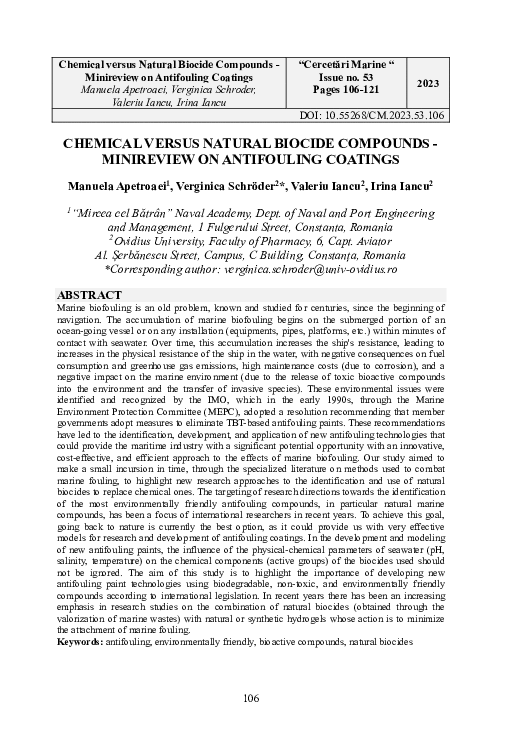Chemical versus Natural Biocide Compounds - Minireview on Antifouling Coatings
DOI:
https://doi.org/10.55268/CM.2023.53.106Keywords:
antifouling, environmentally friendly, bioactive compounds, natural biocidesAbstract
Marine biofouling is an old problem, known and studied for centuries, since the beginning of navigation. The accumulation of marine biofouling begins on the submerged portion of an ocean-going vessel or on any installation (equipments, pipes, platforms, etc.) within minutes of contact with seawater. Over time, this accumulation increases the ship's resistance, leading to increases in the physical resistance of the ship in the water, with negative consequences on fuel consumption and greenhouse gas emissions, high maintenance costs (due to corrosion), and a negative impact on the marine environment (due to the release of toxic bioactive compounds into the environment and the transfer of invasive species). These environmental issues were identified and recognized by the IMO, which in the early 1990s, through the Marine Environment Protection Committee (MEPC), adopted a resolution recommending that member governments adopt measures to eliminate TBT-based antifouling paints. These recommendations have led to the identification, development, and application of new antifouling technologies that could provide the maritime industry with a significant potential opportunity with an innovative, cost-effective, and efficient approach to the effects of marine biofouling. Our study aimed to make a small incursion in time, through the specialized literature on methods used to combat marine fouling, to highlight new research approaches to the identification and use of natural biocides to replace chemical ones. The targeting of research directions towards the identification of the most environmentally friendly antifouling compounds, in particular natural marine compounds, has been a focus of international researchers in recent years. To achieve this goal, going back to nature is currently the best option, as it could provide us with very effective models for research and development of antifouling coatings. In the development and modeling of new antifouling paints, the influence of the physical-chemical parameters of seawater (pH, salinity, temperature) on the chemical components (active groups) of the biocides used should not be ignored. The aim of this study is to highlight the importance of developing new antifouling paint technologies using biodegradable, non-toxic, and environmentally friendly compounds according to international legislation. In recent years there has been an increasing emphasis in research studies on the combination of natural biocides (obtained through the valorization of marine wastes) with natural or synthetic hydrogels whose action is to minimize the attachment of marine fouling.
Downloads
Published
2024-01-31
How to Cite
Apetroaei, M., Schröder, V., Iancu, V., & Iancu, I. (2024). Chemical versus Natural Biocide Compounds - Minireview on Antifouling Coatings. Cercetări Marine - Recherches Marines, 53(1), 106. https://doi.org/10.55268/CM.2023.53.106
Issue
Section
ORIGINAL ARTICLES
License

This work is licensed under a Creative Commons Attribution-NonCommercial-ShareAlike 4.0 International License.
This is an open access journal, which means that all content is freely available without charge to the user or his/her institution. Users are allowed to read, download, copy, distribute, print, search, or link to the full texts of the articles, or use them for any other lawful purpose, without asking prior permission from the publisher or the author. This is in accordance with the BOAI definition of open access.






